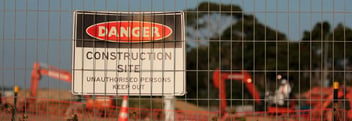Tips and best practices for planning construction projects around severe weather
Having a full construction schedule year-round is ideal for most contractors. They contact clients to review project specifications, perform maintenance on their heavy equipment, and arrange the time for subcontractors to perform this specialized work.
Yet planning for the weather is often a difficult and unpredictable task. When a storm hits, worker and equipment safety must become paramount.
Let’s go over some of the best practices and tips that contractors may take to keep the worksite safe when severe weather strikes, and how to plan around weather events so the construction project moves forward.
Dangers of Severe Weather
When we often talk about severe weather, the common types that come to mind are thunderstorms, high winds, hurricanes, tornadoes, lightning, floods, and blizzards. Yet contractors should also be aware of extreme temperature conditions that impact the workers’ health.
Extremely hot temperatures may cause heat-related illnesses, including heatstroke. On the other side, extremely cold temperatures may cause hypothermia and frostbite.
Both instances may become overlooked simply because workers strive to get their jobs completed before the end of the day to meet deadlines. No extreme weather condition or temperature should be overlooked when planning for construction site safety.
Severe weather may cause a range of heavy equipment problems, from seizing systems to unsteady ground conditions. It may also cause dangers such as equipment being toppled over by high winds or heavy torrential downpours limiting visibility when driving equipment around the construction site.
Tip #1: Understand the Area’s Weather History
Historical weather data may give clarity regarding the types of weather that impacts the area during certain times of the year. While the past references won’t always be exactly accurate in predicting future weather patterns, it can give further clarity on what type of climate is common there.
Tip #2: Use Long-Range Weather Forecast Tools and Alerts
Long-range weather forecast tools allow you to plan out what types of construction projects may go on for that day. If there is light rain predicted, you may have workers doing takes inside buildings while waiting until the outside weather clears up.
You may also utilize severe weather alerts to inform you of surprise severe weather that moves into the area. The alerts may give you enough time to prepare heavy equipment for the weather and to get workers to safety.
Tip #3: Create a Jobsite Checklist for Severe Weather
A severe weather jobsite checklist helps to inform workers on the protocols and procedures to take when ceasing work caused by adverse conditions. Some steps on the checklist may include the following:
- Disconnect power generators, water connections, and gas connections
- Secure temporary structures and lightweight materials to prevent intense winds from toppling them over
- Protect and secure heavy equipment to prevent damage and emergency maintenance repairs
- Cover excavated holes and block drains to prevent flooding
- Cover windows and open doorways with plywood to prevent glass breakage and water penetration
- Remove employees from scaffolding and secure it to buildings to prevent the scaffolding from collapsing
Tip #4: Assign Workers to Storm Preparation Tasks
If you have several hours to a day before the storm arrives, you want to have a few workers available who will help to protect the construction site and keep equipment safe. These workers will also return after the storm to assess damage and help with cleanup efforts.
Tip #5: Stock Up on Emergency Supplies
If workers are caught in a surprise storm or other adverse weather while on the construction site, you want to ensure that they have emergency supplies available. Keep water bottles, flashlights, and first-aid kits handy.
Expect Project Delays Due to Severe Weather
While every contractor has to meet construction deadlines, they can’t control the weather to ensure that every day is sunny outside. Project delays may appear due to severe weather as you may miss a deadline. Yet using the above tips may help better plan out when to take on construction projects and what to do to protect workers when harsh weather strikes.
Read On

How to Make Construction Site Safety Reports
There have been many advances in construction site safety; however, one in five deaths among U.S....

6 Benefits of Construction Material Management
Money doesn’t grow on trees, and construction materials don’t appear out of thin air either....

5 Tips for Construction Material Delivery
Reliable, on-time construction material delivery is key to profitability on any construction...

